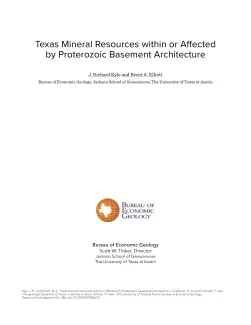
Publication Details
Get the Publication
$8.00
Abstract/Description:
Proterozoic exposures in the Llano Uplift of Central Texas and in the Van Horn area and other smaller areas of western Texas represent less than one percent of the area underlain by Precambrian basement. The geologic units of the Llano Uplift are dominated by felsic gneiss (34 percent), schist (26 percent), and granite (39 percent) that formed during the Mesoproterozoic Grenville orogeny. These lithologies likely form a significant component of the contiguous Texas basement under Phanerozoic strata. The exposed basement provinces of Texas host diverse mineral resource occurrences with modest historic production of copper, silver, gold, iron, rare-earth elements, and industrial minerals, but only dimension stone and talc are commercially viable at present. The widespread occurrence of ductile lithologies (serpentinite, soapstone, hydrothermal talc, micaceous and graphitic schists) vs. postorogenic granite plutons suggests potential differential response to tectonic stress originating from or transferred into the basement. Brittle structural features are common in granite basement, and some are the result of Phanerozoic deformation, dominantly the late Paleozoic Ouachita orogeny. The irregular nature of the Great Unconformity surface, with up to 800 ft (~245 m) of paleorelief, is due to differential erosion of variable basement lithologies during the Neoproterozoic. Basement–basal Paleozoic stratal relationships in Central Texas indicate the presence of a series of north–northwest-trending ridges and valleys. These features caused complex depositional relationships of Cambrian strata with the basement surface. The current nature of the basement–sedimentary cover interface is further complicated by late Paleozoic Ouachita orogenic displacements and by tectonically driven sedimentary brine flow and resulting diagenesis, including formation of sulfide mineral concentrations. Oxidation of sulfide minerals by later fluids generated acids that locally altered basement and Phanerozoic rock units, enhancing porosity and weakening existing fault zones and the contact zone between basement and Phanerozoic cover. The collective results of these events have the potential to create modern zones susceptible to structural adjustment.